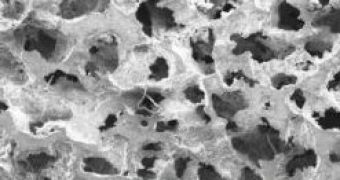Having the ability to bring a structure back to its original shape could present some advantages, if you consider the fact that it also presents strength and some other special features, especially after it has been deformed through the application of a force of physical nature.
Memory-shape materials are mostly designed out of alloys and can be brought back to their original shape with the application of either a weak magnetic field, through a heating process, or just by unloading the stress in the case of superelastic materials. Recently, scientists have developed a new type of alloy, consisting of a nickel-manganese-gallium mix, which has the capability of returning to its original crystalline configuration when a magnetic field is applied.
Furthermore, the new magnetic shape-memory material maintains its shape, after the magnetic field has been removed during the manufacturing stage, and has the capability of 'remembering' it, when the magnetic field is rotated by 90 degrees.
Developed by two scientists from Boise State University, when studied under a powerful microscope, the material looks like a random crystalline structure, with immense voids through it. This special configuration allows it to lengthen or strain, by up to 10 percent of its original dimensions, when a magnetic field is being applied.
In the experiment to test the efficiency of the newly designed material, Peter M?llner and David Dunand used, as a strain force, a magnetic field to simulate the effect of a physical load exerting force. Previous experiments in the study and design of new magnetic shape-memory material proved that the methods used to construct such structure, with large alloy crystals, was incredibly difficult and expensive, more like trying to create diamonds with no original structure to build them on.
Instead, the two researchers figured that a better method, that would enable the easy manufacturing of such materials, might involve creating smaller crystals in the structure. They decided to use polycrystalline alloys that present small crystals in their structure; however, such alloys are often compact and have minimal strains due to the strong chemical bonds between each crystal. This seemed to present some constructive problems, as all previously designed materials presented large strains, because they were composed out of large crystalline structures.
However, the problem of the strain was quickly resolved, by inserting large voids between the small crystals that would greatly reduce the chemical bonds between each crystal, thus greatly expanding the strain.
Like most of the fabrication techniques used to create porous materials, the molten nickel-manganese-gallium alloy is pored onto a sodium aluminate salt that, when cooled, can be extracted by washing the whole structure with a specific acid, which will leave the porous structure of the alloy behind. To better improve the strain of the material, the alloy is subjected to a rotating magnetic field, resulting in performance comparable with some of the best mechanical actuators that are commercially available at the moment.
Although the alloy material was previously available, its magneto-mechanic properties have mostly been disregarded, due to the fact that nobody has tried so far to pore it into a porous structure. Furthermore, its special configuration also makes it light weight, thus it may have multiple future application, if the two researches are successful in improving the crystal lattice structure.

 14 DAY TRIAL //
14 DAY TRIAL //